Anatomy and Physiology the Massage Connection Third Edition Chapter 7 Review Answers
New instructor tips
- "Try walkin' in my shoes."
- "Deconstruct a sport."
- "Option apart a pushup."
Latest news
- Applied Anatomy & Physiology for Manual Therapists, second Edition: At present available!
- A Massage Therapist's Guide to COVID-nineteen Digital Annex: Get your complimentary digital addendum toA Massage Therapist's Guide to Pathology
- Explore this new edition: A Massage Therapist'southward Guide to Pathology, seventh edition
- New Trail Guide editions: Check them out!
- New title: Books of Discovery at present publisher of Practical Anatomy & Physiology for Manual Therapists
- Teacher story: Trail Guide to the Body becomes role of the change for medical education in Republic of albania
- New textbook title: Ruth Werner and A Massage Therapist's Guide to Pathology bring together Books of Discovery
- New instructor tool: Customizable AOIN spreadsheet
Applied Anatomy & Physiology for Manual Therapists, 2nd Edition
Now bachelor!
Nosotros've enhanced a number of features in this new edition. Here are a few of them:
-
 New Unit of measurement Openers present a big-moving picture overview of the body systems covered and how they are interrelated.
New Unit of measurement Openers present a big-moving picture overview of the body systems covered and how they are interrelated. - New chapter-opening "Pre-learning" scenarios bear witness students the connexion betwixt the body systems and our everyday lives.
- Thinking Beyond questions at the terminate of each chapter provide students with opportunities to employ the newly learned A&P content.
- Completely reviewed and updated content reflects the latest best practices.
Asking a review copy.
A Massage Therapist'due south Guide to COVID-19 Digital Annex
Get your gratuitous digital addendum toA Massage Therapist's Guide to Pathology.
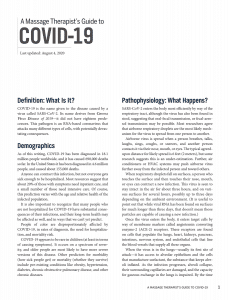
Massage therapists working with clients who have had COVID-19 face new and unique treatment challenges. Focused on evidence-informed massage therapy, Ruth Werner's digital addendum toA Massage Therapist'due south Guide to Pathology prepares hereafter practitioners to make choices that result in optimal outcomes for clients living with the wellness-related consequences of their infections.
Scope of COVID-19 Annex
Ruth Werner'due south original enquiry includes interviews with some of the U.S.'s elevation communicable diseases specialists, setting the standard for massage therapists' COVID-19 pathology instruction. The addendum provides a comprehensive clinical and pathological test of COVID-19:
-
-
-
-
-
-
- Definition: What Is Information technology?
- Demographics
- Pathophysiology: What Happens?
- Complications
- Signs and Symptoms
- Treatment
- Questions for Clients Who Have Had COVID-19
-
-
-
-
-
[Download the addendum now]
Explore this new edition
A Massage Therapist's Guide to Pathology, viith edition
In her newest edition, Ruth Werner, BCTMB — a pioneer of pathology education in massage therapy — empowers students with critical thinking skills to pattern safe, effective, testify-informed treatment plans.
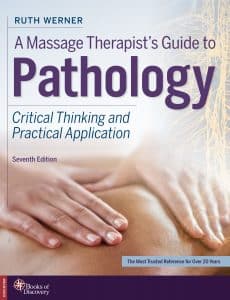 New features in the seventh edition.
New features in the seventh edition.
- Client Profiles relate course material to real-life situations, making pathology relevant for students.
- Disquisitional Thinking, Practical Application Exercises let students apply pathology to the client profiles and engage in real-world learning.
- Utilise What Y'all Know Boxes include the benefits and risks of handling, massage therapy accommodations, and current research.
- Revised Explore and Apply Questions at the finish of each affiliate delve into critical thinking steps.
- Completely Updated Enquiry assists students in designing prophylactic, effective, evidence-informed treatment plans.
Request a review copy.
NewTrail Guideeditions
Check them out!
 Trail Guide to the Trunk, sixth edition
Trail Guide to the Trunk, sixth edition
Featuring updated, full-color illustrations, chapter introductions, and case stories for powerfully effective means to deliver surface anatomy and palpation lessons.
Explore.
Trail Guide to Movement, 2d edition
This fascinating journeying into the world of kinesiology goes even deeper, with xv pages of additional vital content.
Learn more.
Now at Books of Discovery
Applied Anatomy & Physiology for Manual Therapists
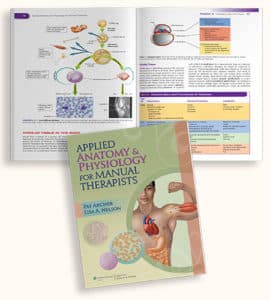 Books of Discovery, with a xx-year history as 1 of the almost respected manual therapy publishers, has added to its list a premier beefcake and physiology (A&P) textbook — Applied Anatomy & Physiology for Manual Therapists, previously published by Lippincott Williams & Wilkins.
Books of Discovery, with a xx-year history as 1 of the almost respected manual therapy publishers, has added to its list a premier beefcake and physiology (A&P) textbook — Applied Anatomy & Physiology for Manual Therapists, previously published by Lippincott Williams & Wilkins.
Originally published in 2013, this textbook engages students with piece of cake-to-understand withal detailed A&P principles that specifically apply to students' future bodywork careers.
Chapter discussions include the benefits, furnishings, indications, and contraindications for manual therapy treatments. Co-authors and learning experts Pat Archer, MS, AT ret, LMT, and Lisa Nelson, BA, AT/R, LMT, approach technical details with a focus on accuracy and interest, making content comprehensive and approachable for students.
Learn more about this textbook.
New instructor tip
Effort walkin' in my shoes
 Write different gait deviations on separate pieces of paper, and enquire a student to cull one. That educatee then walks in the assigned gait to experience the feeling of the gait, muscles involved, and imbalances that exist. Then enquire your class to guess the gait deviation the student was assigned.
Write different gait deviations on separate pieces of paper, and enquire a student to cull one. That educatee then walks in the assigned gait to experience the feeling of the gait, muscles involved, and imbalances that exist. Then enquire your class to guess the gait deviation the student was assigned.
This practise can also be done in smaller groups: assign specific gait deviations to different groups and have each study their Walkin' in My Shoes findings to the grade.
New instructor tip
Deconstruct a sport activity
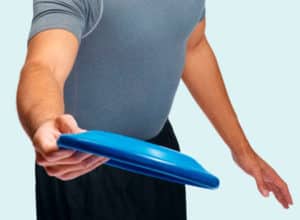 Bring to grade several sport or exercise items such as a Frisbee, bat and ball, Hula Hoop, Hacky Sack, or baton. Ask students to work in pairs. Each pair selects an item and deconstructs the movements involved when using information technology. Take them share their findings with the class.
Bring to grade several sport or exercise items such as a Frisbee, bat and ball, Hula Hoop, Hacky Sack, or baton. Ask students to work in pairs. Each pair selects an item and deconstructs the movements involved when using information technology. Take them share their findings with the class.
Some variations of this lesson can include asking your students to:
- Identify which muscles are used.
- Depict how the muscles are used.
- Compare required upper-body musculus movement to lower-body muscle movement.
- Explain the prime number movers vs. synergists or antagonists.
Instructor story
Trail Guide to the Body becomes role of the alter for medical education in Albania
Takes students beyond rote memorization to practicing and mastering palpation.
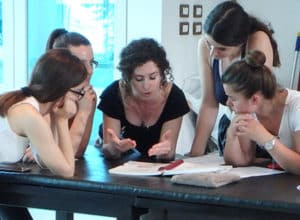 "I wish you lot could see the students start to 'think' and endeavor to effigy out 'office' using their ain bodies and the new textbooks. They aren't just memorizing how to palpate muscles and bony structures, they're visualizing it with the text and and then actually practicing information technology," says Kathy Scott, PT, DPT, an American concrete therapy instructor working for the ABC Health Foundation, a not-for-profit organisation striving to improve medical intendance in Albania.
"I wish you lot could see the students start to 'think' and endeavor to effigy out 'office' using their ain bodies and the new textbooks. They aren't just memorizing how to palpate muscles and bony structures, they're visualizing it with the text and and then actually practicing information technology," says Kathy Scott, PT, DPT, an American concrete therapy instructor working for the ABC Health Foundation, a not-for-profit organisation striving to improve medical intendance in Albania.
Acquire more.
New teacher tip
Option apart a pushup
 Choose an practice to deconstruct — for example, a pushup. Ask students to piece of work in pairs or small groups to identify all the movements required when engaging in that exercise. Instruct them to:
Choose an practice to deconstruct — for example, a pushup. Ask students to piece of work in pairs or small groups to identify all the movements required when engaging in that exercise. Instruct them to:
- Describe how movements occur in the exercise.
- Listing the gild of muscle actions throughout the exercise.
- Ask them to effort using "eccentrically speaking," where the focus is on eccentric contraction instead of concentric.
Consider giving a prize to the pair of students who have the highest number of correct answers.
Available now
A Massage Therapist's Guide to Pathology
Ruth Werner, and her iconic book, have joined our publishing family unit!
 At that place's nothing quite like finding that perfect textbook to augment our product line and accommodate our quickly growing customer base. That's why we've brought this revered, all-time-selling text into our family.
At that place's nothing quite like finding that perfect textbook to augment our product line and accommodate our quickly growing customer base. That's why we've brought this revered, all-time-selling text into our family.
A cornerstone educational resources of many massage therapy programs and already in its 6th edition, A Massage Therapist'south Guide to Pathology is a comprehensive, visually highly-seasoned, and highly respected textbook on pathologies. Organized by body system, the text contains detailed information on the etiology, signs, symptoms, and treatment of more than 500 diseases and conditions. It also helps students discover how massage therapy can positively impact the healing process.
Here are some of our favorite features:
- Case histories in which people living and coping with many of the diseases and conditions share their stories, drawing a real-world connection between the classroom and the clinic.
- Clear illustrations and friendly, attainable content to capture students' attention and make challenging concepts easier to grasp.
- Tables at the end of each affliction description that summarize the benefits, risks, and options for massage therapy.
- A research literacy appendix addressing the demand for evidence-based massage therapy.
- Compare-and-contrast charts that list like weather side-by-side, helping students discern the differences.
- Access to a host of games, exercises, quizzes, videos, and animations, all developed or selected by the author.
Learn more.
New instructor resource
Teach AOIN topics your way.
Customizable Action, Origin, Insertion, and Nerve Innervation Spreadsheet
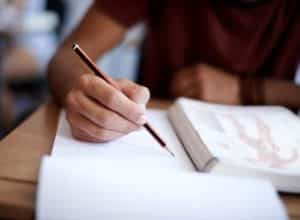
Do you sometimes need more, or less, Action, Origin, Insertion, and Nerve Innervation (AOIN) material than what'southward printed in Trail Guide to the Body? With the new customizable AOIN spreadsheet, it'south easier than ever to teach AOIN data to your standards.
Aggrandize on an AOIN topic. Or, fill in the gaps. Yous can fifty-fifty use your customized spreadsheet to create study guides for your students. Because no one knows precisely what your students need to learn better than you.
- Customize materials quickly in a Microsoft Excel-based spreadsheet.
- Teach students just the specific AOIN information they need.
- Build customized study sheets for your students.
Now available for instructors who crave Trail Guide to the Body for their courses.
Download now.
Instructor tip
Adding some clarity to the deltoid.

Wondering the best means to help students understand the deltoid?
Chances are, your students are unfamiliar with the concept of synergists and antagonists. And then, before you start explaining the deltoid ask, "How could the deltoid peradventure move the shoulder in and so many different directions?"
Adjacent, appoint them visually by using a skeleton as a prop. You might desire to say, "Imagine at that place'south a little guy continuing here on the clavicle. He throws a rope down and hooks information technology on to the deltoid tuberosity. Equally he pulls, the humerus swings up (flexing and medially rotating at the glenohumeral joint)."
Teacher tip
Taking the mystery out of the levator scapula.
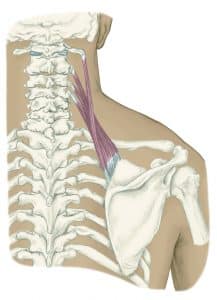 The twisting, three-dimensional aspect of the levator scapula tin can be confusing for students. To make it easier to sympathize, consider cartoon the abdomen of the levator scapula on a shirtless model. This can help them visualize how information technology's on both the posterior and lateral sides of the neck. And so motion the model'south head in various positions, so students tin can run across how the muscle shortens and lengthens.
The twisting, three-dimensional aspect of the levator scapula tin can be confusing for students. To make it easier to sympathize, consider cartoon the abdomen of the levator scapula on a shirtless model. This can help them visualize how information technology's on both the posterior and lateral sides of the neck. And so motion the model'south head in various positions, so students tin can run across how the muscle shortens and lengthens.
Source: https://booksofdiscovery.com/what-is-new/
0 Response to "Anatomy and Physiology the Massage Connection Third Edition Chapter 7 Review Answers"
Enregistrer un commentaire